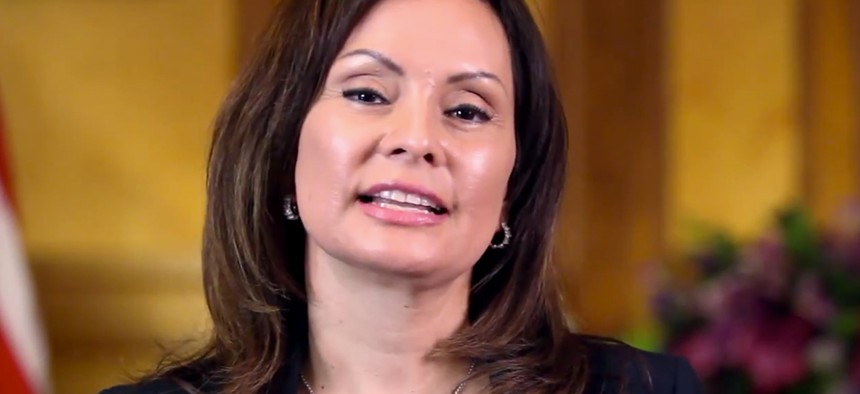
Rosa Gumataotao Rios is the current United States Treasurer. White House via YouTube
Why All of the U.S. Treasurers Since 1949 Have Been Women
For the last six decades, presidents have treated the treasurer position as a low-risk, high-visibility job that promotes the appearance of diversity while rewarding a loyal supporter.
When Janet Yellen made history last year by becoming the first female chair of the Federal Reserve, economists and women’s advocates alike cheered the move. But Yellen’s victory also renewed scrutiny of the gender gap in top financial positions. While other departments such as Commerce and Interior have welcomed female chiefs into their ranks, the Fed and Treasury continue to be populated mostly by graying white men.
However, this oft-repeated narrative of Finance-as-Boys'-Club is incomplete, leaving out the little-known but important fact that every U.S. Treasurer—whose name graces every printed U.S. dollar—has been a woman for the last 60 years. Several of those women have been Latina; one was African American.
At best, this tidbit of information has been just that—an interesting tidbit with little context, with no explanation proffered for this unbroken pattern of solely female treasurers. After seeking out the insight of a feminist economist, a social psychologist, and government scholar, here's my try.
For the last 60 years, U.S. presidents—both Republican and Democratic—have treated the treasurer position as a low-risk, high-visibility job that promotes the appearance of diversity while rewarding a loyal supporter. In other words, the trend has to do with political favoritism, precedent, ceremony, and a bit of (well-intentioned) tokenism.
Let’s start with the first.
President Harry S. Truman started the tradition in 1949 when he appointed Georgia Neese Clark, who campaigned for the Democrats in her Republican home state of Kansas. (The position of treasurer has existed since 1775.) By naming Clark as treasurer, Truman rewarded her loyalty and acknowledged the Democrats’ debt to the votes of women, who had joined the workforce in droves by the end of World War II. The job, like many ambassador positions, has continued to be awarded to women with a history of political activism.
So why did a streak of female treasurers continue uninterrupted after Truman appointed Clark?
“Once there’s a woman appointed in a position, it’s easy to assume that position is one that could be filled by a woman,” says Jennifer Lawless, who directs the Women and Politics Institute at American University. “Once an initial ceiling is broken, once an initial piece of progress is made, there is a tendency to continue down that path.”
Such is the allure of precedent. Once Clark proved herself capable of excelling at a certain position, future presidents felt less inclined to return to the way things used to be, Lawless said.
It’s also worth mentioning that the U.S. treasurer is a more ceremonial job distinct from the powerful treasury secretary—a position that has only ever been held by white men, currently by Jack Lew of meme-worthy signature fame. Current treasurer Rosa Gumataotao Rios, the sixth Latina ever to hold the position, advises top Treasury and finance officials and directly oversees the U.S. Mint and the Bureau of Printing and Engraving. But Rios cannot create fiscal policy the way Lew or Yellen can, nor is her job as crucial to the functioning of the administration as theirs is. Ever since a woman was first appointed, the treasurer position has seen long stretches of vacancies—totaling 3,359 days, or nine years.
So far, all of this points to an ugly, hackle-raising word—tokenism. Rios herself has rejected this assertion.
Part of the decision to choose women and minorities for the treasurer position can boil down to “optics,” according to Alice Eagly, a social psychologist at Northwestern University who has published extensively on women and leadership. Eagly notes that it’s easier for presidents to actively engineer diversity with less-scrutinized positions like treasurer, compared with say, Yellen’s job, for which she wasn’t even the first pick.
But the overall picture softens when you consider that, in addition to their official duties, treasurers also work as ambassadors for economic development in lower-income or underserved communities where the Treasury wants to foster growth. Viewed in this light, “optics” is not a bad thing, according to Heidi Hartmann, an economist and the founder of the Institute for Women’s Policy Research. Marginalized communities, says Hartmann, tend to be deeply suspicious of the government’s financial institutions. (Also part of the Treasury? The IRS.)
So the administration and underserved communities benefit from the treasurer having a minority as a figurehead. President George W. Bush’s appointee, Anna Escobedo Cabral helped displaced victims of Hurricane Katrina who lost access to federal benefit payments and their bank accounts after the storm. Combine Cabral’s profile as a Mexican-American with her working-class upbringing, and she becomes instantly relatable as a spokesperson for promoting financial literacy.
While treasurers aren’t exactly heavyweights in the fiscal world, they’re far from ornamental. Figurehead political positions filled by both men and women abound and can be leveraged to great effect if wielded intelligently. As Lawless points out: “The average American doesn’t know the difference between Janet Yellen’s position and treasurer.” In an oddly serendipitous way, the ignorance of the American public can work to the advantage of women seeking economic positions in the future. Substance might not matter, but appearances do. “If American people see women in positions of economic power, it can help change the perception that women are not qualified for those kinds of jobs,” Lawless says. On the other end, treasurers can use their visibility and strong community ties to eventually run for political office.
“Women [and minorities] need these positions that are kind of earmarked for them,” until broader diversity becomes the rule, not the exception, says Hartmann, the economist. Rare, symbolic positions like the treasurer will—and should—continue to exist, as long as parity remains a goal that sits on an ever-receding horizon.






